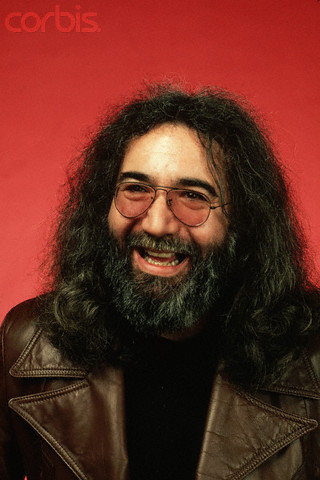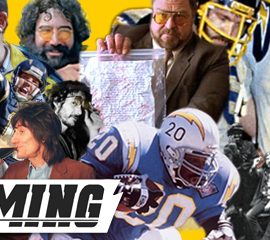This piece combined two of my interests that are not related to the Chargers. It was originally written for the Theodore Roosevelt Association (TRA) Journal under the title “The Old Lion And Papa Bear.” However, it made its way over to American Heritage and was purchased for their website. It appeared there on April 5, 2006. Not everyone approved of my connection between these two figures, but it led to American Heritage purchasing the Hendrix and Springsteen pieces which also appear here.
Theodore Roosevelt And Jerry Garcia: Brothers Under The Skin?
While reading William N. Tilchin’s touching memorial to John Gable in the last TRA Journal, I was instantly forced into a double-take. He recalled that the late Doctor had written him a letter in August of 1995 “that lamented the passing of Jerry Garcia.” I chalked that tidbit up as an interesting anomaly until I later read in Major Gregory A. Wynn’s tribute that Dr. Gable had “attended 13 Grateful Dead concerts. The first was in Providence, RI. The last was in March 1994 in the Nassau Coliseum.” Dr. Gable had apparently verified his show total in his “Commonplace Book,” an idea he had admittedly borrowed from George Washington. These books, whose origins date back to the Renaissance, were originally used to help students understand all the innovations and achievements of the era. Later Commonplace Books of men like Washington and Jefferson contained the words that motivated them and provide historians a unique view of how these figures actually viewed themselves.
That Dr. Gable, a man who reportedly wore his vest completely buttoned up even on the beach, would choose to note in his Commonplace Book his Grateful Dead concert tally was highly surprising, to say the least. But he admitted to Major Wynn in the same 1999 letter that he was eclectic in his tastes. He also revealed in another note that he admired the work of Allen Ginsberg and had even once met the famous “Beat” poet. In an attempt to lift the Major’s spirits in 2002, Dr. Gable evoked the words of Mick Jagger in “You Can’t Always Get What You Want.” I then realized that I had clearly misjudged him and wondered if such a scholar also jotted song lyrics in his Commonplace Book. Maybe he even used some of the same music for inspiration during life’s everyday travails as I do. After placing a call to Dr. Gable’s successor, Ed Renehan, I was told that the Good Doctor had indeed loved “Jerry and the boys.”
Why would I be so interested in a possible connection between a beloved Roosevelt scholar and the Grateful Dead? After 138 (I keep a book of ticket stubs, rather than a Commonplace Book) Dead shows, I thought that I had met fellow Deadheads from every possible walk of life. I once spoke with the recently-departed Peter Jennings at a show and attended another where Walter Cronkite was in attendance. Athletes, actors, even elected politicians also proudly identify themselves as fans. But after but after becoming interested in Theodore Roosevelt, I never thought that any of the authors I was reading might similarly appreciate the Dead’s music. I have written about the band for both books and magazines, but even a 95-page thesis on TR for my Master’s Degree (during which The Bull Moose Years and The Lion’s Pride were invaluable resources) didn’t trigger the idea that there might be a connection between these two subjects. When I suggested the subject matter to our new Executive Director, he encouraged me to pursue any possible parallels between Theodore Roosevelt and Jerry Garcia.
I first became fascinated by TR after the 1997 PBS broadcast of the “American Experience” program. More than any other element of his personality, I was most attracted to Roosevelt’s attempt to squeeze every last moment out of the “Strenuous Life” he led. Amidst my many pictures of Jerry Garcia, I keep the title page from Nathan Miller’s Roosevelt biography in a frame next to my bed. Under the photo of TR flashing his trademark smile are the words: “Life is a great adventure, and the worst of all fears is the fear of living.” I have found this quotation to be more inspirational than any other for facing the everyday challenges of our existence. In fact, both of these American icons are remembered and revered for their desire to maximize their time on the planet.
TR’s fearless style in both his personal and political life was what first grabbed me about him. I may not agree with or view a success all of his actions while in office, but I appreciate the style with which he did it. This is not very different from the reasons I love the music of the Grateful Dead. They were famous for never having played the same set in the same way over the course of thirty years. They were able to do this because they used their songs as the framework for lengthy improvisational pieces, just as Miles Davis and John Coltrane revolutionized jazz with. Jerry Garcia was primarily responsible for the launch and landing of the Dead’s trademark jams. Sometimes these explorations would fail miserably and other times they would never get going at all. But when they worked, there was nothing like it in music history. It was pure magic. It was their courage in taking chances night after night that made me, and countless others, love them. As Jerry said himself, “You do not merely want to be considered just the best of the best. You want to be considered the only ones who do what you do.”Theodore Roosevelt and Jerry Garcia also faced similar obstacles growing up. They both overcame severe physical maladies during their childhood. At the urging of his father, TR “remade himself” after being stricken with asthma. Jerry had to learn to play guitar without the middle finger of his right hand after it was accidentally chopped off with an ax by his brother. Ironically, Jerry’s famous guitar tone is undoubtedly a result of his efforts to compensate for his missing digit just as many of TR’s attitudes and ideals were a result of his quest to “remake his body.”
Many “Tedheads” also credit the human tornado that was TR to his attempt to grapple with the deaths of his father, first wife and child. “Black care rarely sits behind a rider whose pace is fast enough,” were the words TR was left with after he lost the only man he admittedly ever feared. While some of his personal and political actions may have been Roosevelt’s seeking approval of his father, others may have been an attempt to outdo him. For instance, TR’s romantic notions about war could be arguably interpreted as his desire to erase his father’s neglect to “answer the call” of the Civil War.
Jerry Garcia was not nearly as close to his father, but had to face his death in an even more direct fashion. While on a childhood fishing trip, Jerry witnessed his father’s drowning. After living with his grandparents for a short period, Jerry moved in with his mother at the waterfront hotel and bar she ran on the San Francisco’s waterfront district. After that, it was on to Palo Alto during “Beat” period. Later, the Dead would live at 710 Ashbury Street, next to the famous intersection that would come to represent the musical, political and social revolution of the 1960s counterculture movement.
In order to cope with the immense grief caused by the deaths of his first wife and daughter, Theodore Roosevelt took refuge in what he saw as America’s last great frontier, the Badlands. Just as he had “remade” his body during his childhood asthmatic bouts, he now rebuilt himself emotionally, philosophically and politically. This was an even greater challenge. He now had to face emotional pain that surpassed any of the physical frailties he faced in his youth. But it was his harnessing of the nation’s pioneer spirit (at least his interpretation of it),that transformed him into the public figure that would take American politics by storm. For the rest of his days, Theodore Roosevelt would keep a breakneck pace to try to stay clear of the “black care” his father warned him about.
In the 1960s, the closest thing the United States had to the untamed world of the Badlands was Northern California. It was there that Jerry Garcia met Robert Hunter, the man who penned the words to most of his original songs, while both men were sleeping in their cars and living on canned fruit. How’s that for the frontier spirit? During the Grateful Dead’s formative years, Jerry’s ideals, attitudes and subsequent musical style would be shaped not only by other musicians, but poets, painters and authors. In fact, Jerry would always dabble in painting, although the world would not really see any of his work until it adorned a best-selling line of neckties.
The freedom espoused in Jack Kerouac’s On The Road (only now being successfully adapted for the big screen) was also a profound influence on Jerry and the band would soon spend countless hours with Neal Cassady, Kerouac’s model for Dean Moriarity. “Cowboy Neal” was one of the “Merry Pranksters” led by author Ken Kesey, who wrote One Flew Over The Cuckoo’s Nest. Allen Ginsberg would also be a frequent visitor to the entourage that was quickly surrounding Jerry and the Dead. The psychedelic antics of this period were later chronicled in Tom Wolfe’s book, The Electric Kool-Aid Acid Test.
Psychedelic antics? Electric Kool Aid? Acid Tests? How could these things possibly connect to Theodore Roosevelt? How could a true TR enthusiast draw the blasphemous parallel between “that damned cowboy” and a guitar player who died in a rehabilitation facility while trying to kick a nasty heroin habit? TR brought a libel suit on the men who alleged he had a drinking problem during his later years.
But any true Roosevelt scholar should be especially sympathetic to the sort of generalizations that any figure must endure to receive “icon” status. Jerry Garcia truly believed that psychedelics could open your eyes to life’s great adventure. In a 1972 interview with Yale Law Professor Charles Reich, Jerry confessed that “To get really high is to forget yourself. And to forget yourself is to see everything else.” Originally, “getting high” wasn’t about numbing yourself with drugs. I attended 138 Grateful Dead concerts, at least one of which I can confirm I shared with Dr. Gable, and was able to forget myself without doing so at a single one. Unfortunately, Jerry was never able to get high without drugs and that need to expand boundaries led him to narcotics from the 1970s until the end of his life. His intake of increasingly harder and harder drugs became Jerry’s attempt to cope and his addiction, coupled with his legendary girth, ended up killing him.
As the band grew into a touring and moneymaking monster, Jerry tried to take time off. The band even took a year-long hiatus in 1975, to try to scale things back a bit. In 1991, the other band members recognized that he needed to take a break to get some rest and some help. But Jerry’s love of playing music and the need to feed the corporate beast kept him touring. These addictive substances prove fatal, especially when you are viewed as a “guru” by millions of fans and a provider of health care by hundreds of employees who worked for Grateful Dead Productions. I’m not referring to the traveling bazaar of Deadheads you may have seen sweep through your town. I’m referring to the highly-profitable corporation who handled the legal merchandising of everything from Grateful Dead skiis, golf balls, Swiss Army watches and baby clothes.
It is no secret that many of the same characteristics that made Theodore Roosevelt a legend also helped to tarnish it. His 1912 presidential campaign, chronicled so eloquently in Dr. Gable’s The Bull Moose Years and most recently in When Trumpets Call, perfectly exemplified this. While we can now see the roots of the Progressive platform in TR’s schism from the Republican party, it was seen at the time as an example of Roosevelt’s inability to subordinate his massive ego. In exchange for receiving his status as an American icon, TR was victimized and simplified by the mythmaking machine. His legend would also hinder him. When most Americans think of the figure that stares down from Mt. Rushmore they do not consider the misogynist, jingoist and racist elements of the Roosevelt myth. Much like TR, Jerome John Garcia (he was named after composer Jerome Kearn) was far more than the literal and figurative caricature that was painted of him. For both of these men, deification came with a price.
Of course, they both attracted a cult-like following during their lifetime. They still do. To this day their images adorn countless memorabilia items. Can you imagine the marketing campaign that would surround TR if he lived today? But of these figures came along at the perfect time. Nonetheless, their words continue to inspire. Roosevelt’s most poignant lessons for today’s executive were culled together for Theodore Roosevelt On Leadership and The Man In The Arena was distributed to great acclaim to U.S. troops in 2003. Similarly, some of Jerry’s witticisms have found their way into The Wisdom Of Jerry Garcia (1995). “If you’re able to enjoy something, to devote your life to it or a reasonable amount of time and energy, it will work out for you,” “Your best strength comes from having a secure knowledge about what’s going on, having a real solid foundation and knowing where you are” and “Let’s go for it, because what else do we have?” may not have the Rooseveltian flair or his eloquent language. But taken at face value, these aphorisms do not seem that dissimilar from TR’s most memorable utterances.
Jerry Garcia’s true “arena” was the concert stage. Even though many of the lyrics he sang were penned someone else, it was Jerry’s delivery that resonated with his listeners. Just like TR, Jerry was a true authentic American. His voice, never the most technically strong part of his musical repertoire to begin with, grew even more raggedy with age. But he moved countless listeners because he made them believe he had actually experienced the things he was singing about, even when he hadn’t. It is staggering to think of how many high school seniors have included something Jerry Garcia sang in their yearbook entry. I’m not even counting “What a long, strange trip it’s been.”
Most of all, Jerry Garcia will be remembered for his those unmistakable guitar licks. His stage presence bordered on grandfatherly even when he was young. But his fluid playing style is inimitable. Jerry Garcia was what the French call an auteur. When you hear him playing, you can instantly recognize it. Theodore Roosevelt also became famous not only for what he did but how he did it. Those that were able to hear him personally were immediately struck by his high-pitched staccato voice. For the rest of us, the fist-pounding and thrusting provides us a photographic evidence of his famous delivery. History remembers these men for their “outlaw ideology,” because their actions and style were all their own. But what they really had was an unquenchable thirst for life. That, more than anything, is what characterized their work.
Ultimately, the “great adventure” that Theodore Roosevelt used to describe life’s journey is what truly connects these two figures. Just as the elements of the “Rough Rider” image that were actually part of TR propelled him to the very end of his life, Jerry Garcia never stopped being the “good time pirate” he described himself as during the Grateful Dead’s formative years. Like Theodore Roosevelt, his zest for life’s journey is what I love most of all about his work. Both of these men could have been more cautious and subsequently live longer. Had TR not traveled to the River of Doubt, he may have lived long enough to make that last run for the presidency in 1920. But that simply wasn’t Theodore Roosevelt’s style. He lived the “the strenuous life” to the very end. Jerry could also have played things a little safer. But then he would have stopped being what made him great. The real tragedy is that his style didn’t allow him to take better care of himself. However, Jerry Garcia died ten years ago with a smile on his face. That’s the most definitive evidence that, like TR, he wouldn’t have done it any other way.
During the aforementioned 1972 conversation with Professor Charles Reich, Jerry Garcia offered up the closest thing he ever had to a governing philosophy: “Essentially, I think that life is a progressive matter. Going through life you find that there any true setbacks, you just continue to know more, to find more out. More stuff happens to you and more things become known to you. It’s continual.” If TR had been alive to hear that he would have probably awarded it a hearty “BULLY!” He would most likely have needed a translator to understand the statement, but there is no doubt that he would subscribe to the sentiment. In fact, that quotation sounds like something you could write in a Commonplace Book. You could even put in a frame next to your bed. It all depends on your style, be it vests and pocket watches or T-shirts and shorts.
Ross Warner writes often about the Grateful Dead.
Add The Sports Daily to your Google News Feed!





